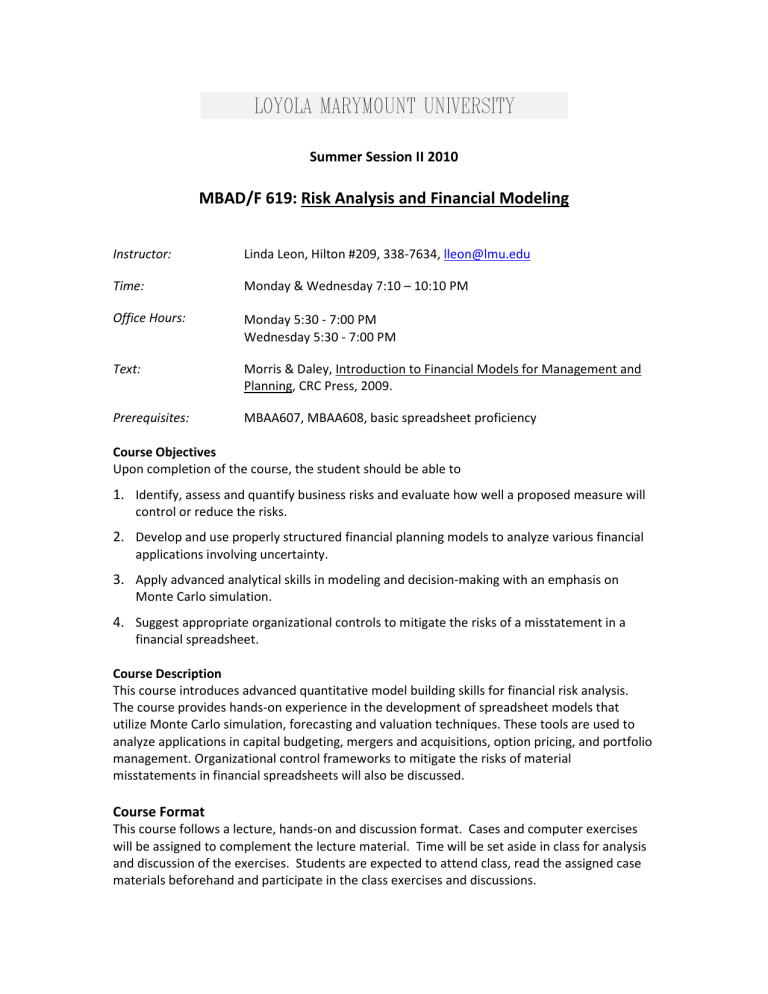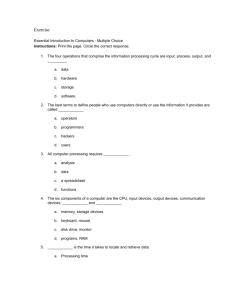Summer Session II 2010 - Loyola Marymount University

Summer Session II 2010
MBAD/F 619: Risk Analysis and Financial Modeling
Instructor: Linda Leon, Hilton #209, 338-7634, lleon@lmu.edu
Time:
Office Hours:
Text:
Monday & Wednesday 7:10 – 10:10 PM
Monday 5:30 - 7:00 PM
Wednesday 5:30 - 7:00 PM
Morris & Daley, Introduction to Financial Models for Management and
Planning, CRC Press, 2009.
Prerequisites: MBAA607, MBAA608, basic spreadsheet proficiency
Course Objectives
Upon completion of the course, the student should be able to
1.
Identify, assess and quantify business risks and evaluate how well a proposed measure will control or reduce the risks.
2.
Develop and use properly structured financial planning models to analyze various financial applications involving uncertainty.
3.
Apply advanced analytical skills in modeling and decision-making with an emphasis on
Monte Carlo simulation.
4.
Suggest appropriate organizational controls to mitigate the risks of a misstatement in a financial spreadsheet.
Course Description
This course introduces advanced quantitative model building skills for financial risk analysis.
The course provides hands-on experience in the development of spreadsheet models that utilize Monte Carlo simulation, forecasting and valuation techniques. These tools are used to analyze applications in capital budgeting, mergers and acquisitions, option pricing, and portfolio management. Organizational control frameworks to mitigate the risks of material misstatements in financial spreadsheets will also be discussed.
Course Format
This course follows a lecture, hands-on and discussion format. Cases and computer exercises will be assigned to complement the lecture material. Time will be set aside in class for analysis and discussion of the exercises. Students are expected to attend class, read the assigned case materials beforehand and participate in the class exercises and discussions.
Course Requirements and Grading Policy
Two spreadsheet modeling cases will be assigned and graded. The spreadsheet model files will be turned in along with a typed paper which provides documentation of the model assumptions and design as well as an analysis of the decision problem based on the information generated with the user’s model. It is expected that all students will work independently on the cases; thus all models and recommendations should be unique. The second case will require data collection for input to the model.
There will be two closed book, closed note exams. Both exams will require the use of the classroom laptop and will test the material covered in the previous lectures.
There will be short computer and small group class exercises as well as case discussions throughout the semester. Most of these materials will be collected and graded to determine the student’s class participation grade. Class attendance throughout the semester is important to receive full credit for your class participation score. The lowest class exercise score will be dropped from your grade calculation.
Homework problems will also be assigned to reinforce the material taught in class. These problems are for the student's benefit and will not be collected or graded. Solutions and models will be provided so that students can check their work. Many of the problems will be included in class discussion.
The final course grade will be distributed as follows:
ASSIGNMENT WEIGHT
Case 1: Capital Budgeting
Case 2: Option Pricing
Exam 1
Exam 2
Class Participation
18%
18%
26%
26%
12%
TOTAL 100%
All assignments will be graded on the scale 0-100. The point scores will then be combined according to the above weights at the end of the course and a letter grade will be assigned on the final total score according to the following guidelines:
Final % Score
93 - 100
Grade
A
Final % Score Grade
70 - 75 C+
90 - 92
86 - 89
80 - 85
76 - 79
A-
B+
B
B-
66 – 69
60 – 65
Below 60
C
C-
F
Important Notes:
1.
Files containing preliminary case models, solutions, powerpoint slides and other spreadsheet examples will be distributed to the class via the internet at http://myweb.lmu.edu/lleon/mbaf619 or on MyLMUConnect. Students will be expected to submit their spreadsheet models in the assignment section of MyLMUConnect.
Grade updates, discussion boards, spreadsheet articles, databases and reference materials will also be available through MyLMUConnect.
2.
Cases will be accepted one class lecture late with a 10 point penalty. Arrangements due to special circumstances may be made with the instructor before the due date.
3.
The exams must be taken at the assigned time. No makeup exam will be given without a valid reason and PRIOR authorization from the instructors.
4.
This course requires the use of Excel add-ins, in particular Solver, @Risk and VBA. A one year access to the @Risk software for the PC is available with the purchase of the course text.
5.
If you use a MAC, you should be aware that Excel 2008 will not run the Excel add-ins needed for a portion of this class. Please see the Document Section in Blackboard that describes one work-around solution for Solver. Otherwise, you should be aware that if you want to use your Mac for course purposes, it is your responsibility to virtualize your
Mac to run a Windows machine on it so that essential course software can be installed and run. You can do this by creating a dual boot machine or by using virtualization software (such as VMWare). You are responsible for learning about all the adjustments necessary regarding the different keystrokes in the Mac, since instructional examples will be provided in the Windows environment. Similarly, during the two exams, you will be expected to use the classroom PCs which operate in the Windows
environment.
6.
The CBA Computer Lab in the Hilton basement has computers that are set-up with VBA and Solver for this course. This lab has limited hours so make sure you are available during its operating hours if you do not install the add-in software on your own system.
7.
In accordance with the University’s academic honesty and integrity regulations, no cheating of any kind will be tolerated with regard to any work in the course. Cheating on any part of the coursework will result in a score of 0 for the corresponding work.
8.
Additional readings besides those listed in the course outline will be assigned as necessary. The scheduled course outline may also be adjusted as necessary.
9.
Students with special needs who need reasonable modifications, special assistance, or accommodations in this course should promptly direct their request to the Disability
Support Services Office. Any student who currently has a documented disability
(physical, learning, or psychological) needing academic accommodations should contact the Disability Services Office (Daum Hall # 224, x84535) as early in the semester as possible. All discussions will remain confidential. Please visit www.lmu.edu/dss for additional information.
Week Day
1 M
2
3
W
M
W
M
W
Date
6/28
6/30
COURSE OUTLINE
Topic
Introduction to Course
Financial Planning and Modeling:
Spreadsheet Engineering;
Equilibrium and Variable Plugs;
Influence Diagrams
Financial Statement Modeling:
Financial Ratio Analysis
Case Discussion: Mark X Company
Base-Case & What-if Analysis:
Data Tables & Sensitivity Analysis
Class Exercise 1
7/5
7/7
7/12
7/14
**July 4 th Holiday**
Monte Carlo Simulation and Risk Analysis:
Input Distributions;
Convergence;
Parameter Interval Estimation for Outputs
Class Exercise 2
HOMEWORK: Exercise 3 to be submitted by Monday
Financial Statement Models for Valuation
Case Discussion: Computer Concepts
Discussion of Case 1: Capital Budgeting
@Risk software demonstration
* EXAM 1 *
Week Day Date
4
Topic
M 7/19 Visual Basic for Applications:
Using Macros to Create Front and Back End Interfaces;
Creating User-defined Input Distribution Functions
W 7/21 Portfolio Models;
Efficient Portfolios and the Efficient Frontier;
Value at Risk (VaR)
Class Exercise 4
* CASE 1 DUE *
5
6
M 7/26 Option Pricing:
Databases for Estimating Returns & Volatility;
Black-Scholes Model;
Portfolio Insurance
Class Exercise 5
Discussion of Case 2: Option Price Simulation
W 7/28 Input Data Analysis for Financial Modeling:
Forecasting Models;
Eliciting Expert Opinions
Class Exercise 6
M 8/2 Spreadsheet Management
Class Exercise 7
* CASE 2 DUE *
W 8/4 * EXAM 2*





